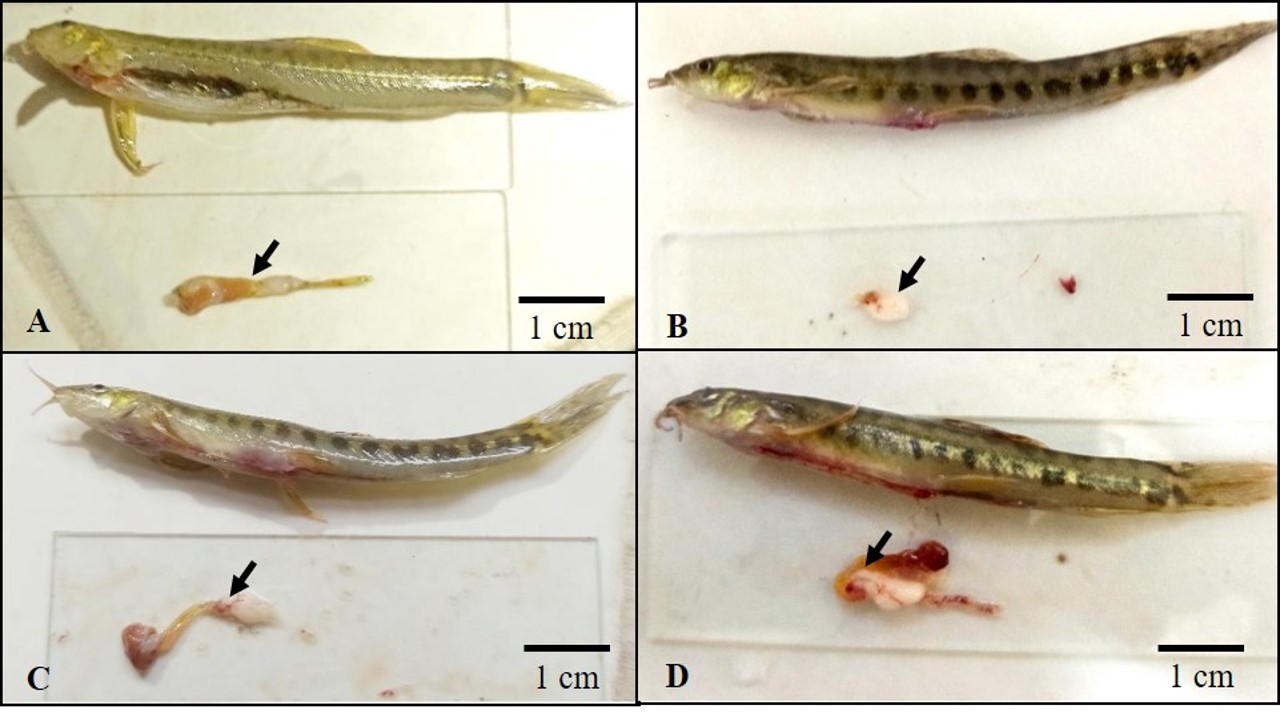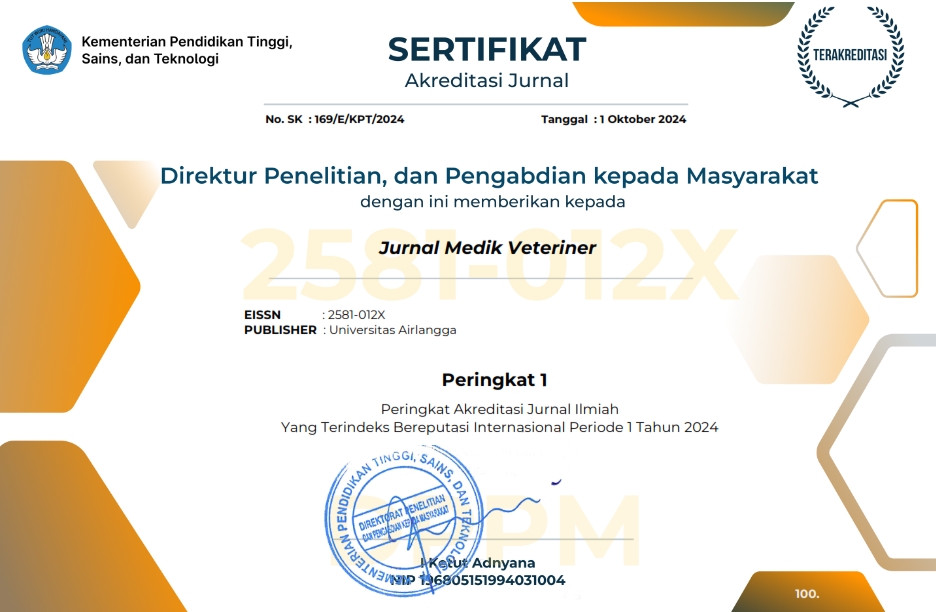Gonadal Maturation and Spawning of Barred Loach (Nemacheilus fasciatus) Induced by Topical Gill Hormone Application

Downloads
Barred loach Nemacheilus fasciatus are unable to reproduce naturally in captivity due to the lack of environmental cues and gonadal maturation occurs slower than in the wild. To optimize breeding procedures for this fish species, we determined whether hormone application via the gills was an effective process and assessed hormone dosage treatments. Oodevâ„¢ was used to induce gonadal maturation and Ovaprimâ„¢ was used to induce spawning via a topical gill approach. Multiple maturation parameters such as gonadal-somatic index (GSI) and hepatosomatic index (HSI), fecundity, and egg diameter; and spawning parameters such as latency period, egg produce, fertilization rate (FR), hatching rate (HR), survival rate (SR) were recorded and compared between the hormone dosage treatments and control treatment. Both the Oodevâ„¢ gonadal maturation induction and Ovaprimâ„¢ spawning induction were effectively applied to barred loach via topical gill application. Gonadal maturation parameters were positively correlated with dosage and all were significantly different. Fry survival rate was not different between doses. The optimal dose of Oodevâ„¢ (0.75 µL/g fish) resulted in male GSI of 5.334 ± 0.320%, female GSI of 15.501 ± 0.675%, male HSI of 0.416 ± 0.023%, female HSI of 1.670 ± 0.104%, egg fecundity 4584.20 ± 493.216 eggs, egg diameter 0.964 ± 0.0151 mm. Ovaprimâ„¢ optimal dosage (3.00 µL/g female and 1.50 µL/g male) was resulted latency period 11.05 ± 0.52 hours, egg produced 3504.83 ± 358.57, FR 96.77 ± 0.88%, HR 83.62 ± 3.78%, and SR 91.44 ± 2.53%.
Adawiyah, L. Al, Sulmartiwi, L., Bodur, T., & Budi, D. S. (2019). Induction of spermiation using ovaprimTM with topical gill method in the silver rasbora (Rasbora argyrotaenia). Theriogenology, 126, 172–176.
Agustinus. (2013). Reproduction performance by injection Oodev on vitelogenesis at rematuration of catfish (Pangasius hypophthalmus) broodstock in fish farming pond. Fish Scientiae, 3(5), 10–16.
Anderson, G. W., Genz, J., & Mcdougall, C. (2013). Using OvaprimTM as a conservation tool for lake sturgeon, Acipenser fulvescens: The short and long term effects of endocrine manipulation during the reproductive cycle.
Anwar, K., Bijaksana, U., Herliwati, H., & Ahmadi, A. (2018). Oodev Injection Frequency and Time Period in Advancing Gonad Rematuration of Snakehead (Channa striata Blkr) in Hapa System. International Journal of Environment, Agriculture and Biotechnology, 3(3), 1114–1123.
Arfah, H., Maftucha, L., & Carman, O. (2006). Induced spawning of giant gouramy Osphronemus gouramy Lac. by Ovaprim. Jurnal Akuakultur Indonesia, 5(2), 103–112.
Baumgartner, L. J., Conallin, J., Wooden, I., Campbell, B., Gee, R., Robinson, W. A., & Mallen-Cooper, M. (2014). Using flow guilds of freshwater fish in an adaptive management framework to simplify environmental flow delivery for semi-arid riverine systems. Fish and Fisheries, 15(3), 410–427.
Brewer, S. K., Rabeni, C. F., & Papoulias, D. M. (2008). Comparing histology and gonadosomatic index for determining spawning condition of small-bodied riverine fishes. Ecology of Freshwater Fish, 17(1), 54–58.
Cejko, B. I., Krejszef, S., Å»arski, D., Judycka, S., TargoÅ„ska, K., & Kucharczyk, D. (2018). Effect of carp pituitary homogenate (CPH) and sGnRHa (Ovaprim) on northern pike (Esox lucius) spermiation stimulation and its effect on quantity and quality of sperm. Animal Reproduction Science, 193, 217–225.
Çek, S., Bromage, N., Randall, C., & Rana, K. (2001). Oogenesis, Hepatosomatic and Gonadosomatic Indexes, and Sex Ratio in Rosy Barb (Puntius conchonius). Turkish Journal of Fisheries and Aquatic Sciences, 1, 33–41.
Cerdá, J., Calman, B. G., LaFleur, G. J., & Limesand, S. (1996). Pattern of vitellogenesis and follicle maturational competence during the ovarian follicular cycle of Fundulus heteroclitus. General and Comparative Endocrinology, 103(1), 24–35.
Christakos, S., & Bahl, O. P. (1979). Pregnant mare serum gonadotropin. Purification and physicochemical, biological, and immunological characterization. Journal of Biological Chemistry, 254(10), 4253–4261.
Dorafshan, S., Mostafavi, H., & Amiri, B. M. (2003). Induction of spawning in common carp Cyprinus carpio, using pituitary extract and GnRH analogue in combination with Domperidone. Iranian Journal of Biotechnology, 1(4), 213–217.
Fikri, F., Wardhana, D. K., Purnomo, A., Khairani, S., Chhetri, S., & Purnama, M. T. E. (2022). Aerolysin gene characterization and antimicrobial resistance profile of Aeromonas hydrophila isolated from milkfish (Chanos chanos) in Gresik, Indonesia. Veterinary World, 15(7), 1759.
Fikri, F., Purnomo, A., Chhetri, S., & Purnama, M. T. E. (2023). Sea Cucumber-Based Hydroxyapatite-Chitosan Ameliorate Serum Liver Enzymes and Cytokine Levels in Albino Rats with Femoral Bone Defect. Indian Veterinary Journal, 100(7), 23–26.
Froese, R., & Pauly, D. (2022). Nemacheilus fasciatus (Valenciennes, 1846) Barred loach. FishBase. https://www.fishbase.se/summary/Nemacheilus-fasciatus.html.
Hill, J. E., Baldwin, J. D., Graves, J. S., Leonard, R., Powell, J. F. F., & Watson, C. A. (2005). Preliminary observations of topical gill application of reproductive hormones for induced spawning of a tropical ornamental fish. North American Journal of Aquaculture, 67, 7–9.
Hill, J. E., Kilgore, K. H., Pouder, D. B., Powell, J. F. F., Watson, C. A., & Yanong, R. P. E. (2009). Survey of Ovaprim use as a spawning aid in ornamental fishes in the United States as administered through the University of Florida Tropical Aquaculture Laboratory. North American Journal of Aquaculture, 71, 206–209.
Hismayasari, I. B., Marhendra, A. P. W., Saidin, S. R., & Supriyadi, D. S. (2015). Gonadosomatic index (GSI), hepatosomatic index (HSI) and proportion of oocytes stadia as an indicator of rainbowfish Melanotaenia boesemani spawning season. International Journal of Fisheries and Aquatic Studies, 2(5), 359–362.
Jenney, C. J., Nemec, Z. C., Lee, L. N., & Bonar, S. A. (2022). Increased juvenile native fish abundance following a major flood in an Arizona river. Journal of Freshwater Ecology, 37(1), 1–14.
Kawarazuka, N., & Béné, C. (2011). The potential role of small fish species in improving micronutrient deficiencies in developing countries: Building evidence. Public Health Nutrition, 14(11), 1927–1938.
Khan, A. M., Shakir, H. A., Ashraf, M., & Ahmad, Z. (2006). Induced spawning of Labeo rohita using synthetic hormones. Punjab University Journal of Zoology, 21(1–2), 67–72.
Kottelat, M., Whitten, A. J., Nurani, K. S., & Soetikno, W. (1993). Freshwater fishes of Western Indonesia and Sulawwesi (Issue July 2009). Periplus Editions Ltd.
Mañanós, E., Duncan, N., & Mylonas, C. C. (2009). Reproduction and control of ovulation, spermiation and spawning in cultured fish. In E. Cabrita, V. Robles, & P. Herráez (Eds.), Methods in Reproductive Aquaculture Marine and Fresh Water Species (pp. 3–80). CRC Press, Taylor and Francis Group.
Marimuthu, K., Kumar, D., & Haniffa, M. A. (2007). Induced spawning of striped snakehead, Channa striatus, using Ovatide. Journal of Applied Aquaculture, 19(4), 95–103.
Mellisa, S., Hasri, I., & Ramdayani, K. (2022). Induction of oocyte developer hormones (oodev) on the maturity of Poropuntius tawarensis. E3S Web of Conferences, 339(September 2020), 01009.
Muchlisin, Z. A., Arfandi, G., Adlim, M., Fadli, N., & Sugianto, S. (2007). Induced spawning of seurukan fish, Osteochilus vittatus (Pisces: Cyprinidae) using ovaprim, oxytocin and chicken pituitary gland extracts. AACL BIOFLUX, 7(5), 27–38.
Mukti, A. T., Sari, Y. G. P., Agusdinata, G. S. R., Satyantini, W. H., Mubarak, A. S., Luqman, E. M., & Widjiati. (2020). The effects of laserpuncture on gonadal maturity and sperm quality of male striped catfish (Pangasianodon hypophthalmus). Theriogenology, 147, 102–107.
Mylonas, C. C., Fostier, A., & Zanuy, S. (2010). Broodstock management and hormonal manipulations of fish reproduction. General and Comparative Endocrinology, 165, 516–534.
Nainggolan, A., Agus Oman, S., Bambang Priyo, U., & Enang, H. (2014). Ovarian Maturation in Asian Catfish (Clarias sp.) by Combination Oodev and Nutrition Addition Spirulina plantesis. International Journal of Sciences: Basic and Applied Research, 15(1), 564–583.
Ningrum, D. R. K., Budi, D. S., & Sulmartiwi, L. (2019). Spawning induction of silver rasbora (Rasbora argyrotaenia) using Ovaprim different doses. Jurnal Ilmu-Ilmu Perairan, Pesisir Dan Perikanan, 8(2), 117–124.
Palermo, R. (2007). Differential actions of FSH and LH during folliculogenesis. Reproductive BioMedicine Online, 15(3), 326–337.
Podhorec, P., & Kouril, J. (2009). Induction of final oocyte maturation in Cyprinidae fish by hypothalamic factors : A review. Veterinarni Medicina, 54(3), 97–110.
Prakoso, V. A., Subagja, J., & Kristanto, A. H. (2017). Aspect of reproductive biology and growth pattern of barred loach (Nemacheilus fasciatus) reared in aquarium. Media Akuakultur, 12(2), 67–74.
Prakoso, V. A., Subagja, J., Arifin, O. Z., Ath-thar, M. H. F., & Kristanto, A. H. (2021). Pembenihan Ikan Uceng Nemacheilus fasciatus. In A. H. Kristanto, R. Gustiano, & K. Sugama (Eds.), Pembenihan Ikan Air Tawar Asli Perairan Indonesia (1st ed., Vol. 1, Issue July, pp. 87–96). AmaFRaD press.
Putri, D. K., Tarsim, Utomo, D. S., & Yudha, I. G. (2019). The stimulation of gonad maturity of Asian redtail catfish Hemibagrus nemurus (Valenciennes, 1840) through induction of oocyte developer (Oodev) Hormone. E-Jurnal Rekayasa Dan Teknologi Budidaya Perairan, 8(1), 965–974.
Rahdari, A., Gharaei, A., & Ghaffari, M. (2014). Spawning latency period in hormonal induced reproduction of snow trout (Schizothorax Zarudnyi (Nikolskii, 1897)). Iranian Journal of Biotechnology, 12(1), 1–5.
Safira, A., Rani, C. A. M., Puspitasari, R. A., Ayuningtyas, A. K. P., Mahendra, Y. A., Purnomo, A., Fikri, F., Chhetri, S., & Purnama, M. T. E. (2022). Amino Acid and Proximate Analysis of Type-1 Collagen from Sea Cucumber and Tilapia-Skin and its Potential Application as Artificial Tendon. Pharmacognosy Journal, 14(4).
Safira, A., Rani, C. A. M., Fikri, F., Purnomo, A., Khairani, S., Chhetri, S., Maslamama, S. T., & Purnama, M. T. E. (2023). Hydroxyapatite-chitosan composites derived from sea cucumbers and shrimp shells ameliorate femoral bone defects in an albino rat model. Veterinary World, 16(5).
Sahoo, S. K., Giri, S. S., & Chandra, S. (2008). Induced Spawning of Clarias batrachus (Linn.): Effect of Ovaprim Doses and Latency Periods on the Weight of Stripped Eggs and Ovary. Asian Fisheries Science, 21, 333–338.
Salmatin, N., Mubarak, A. S., & Budi, D. S. (2021). Egg diameter of female silver rasbora (Rasbora argyrotaenia) at different gonadal maturity stage. IOP Conference Series: Earth and Environmental Science, 718(1), 012066.
Susilo, U., Rachmawati, F. N., Wibowo, E. S., Pradhyaningrum, R. R., Okthalina, K., & Mulyani, M. N. A. (2022). Digestive Enzyme Activities in Barred Loach (Nemacheilus fasciatus, Val., 1846.): Effect of pH and Temperature. Molekul, 17(2), 219–228.
Tjahjo, D. W. H., Purnamaningtyas, S. E., & Purnomo, K. (2017). Eco-biology of uceng (Nemacheilus fasciatus) in Lekso Stream, Blitar. Jurnal Penelitian Perikanan Indonesia, 6(2), 13.
Copyright (c) 2024 Darmawan Setia Budi, Buyung Raga Ardiyan, Dani Bagus Rahmawan, Josie South, Arif Habib Fasya, Akhmad Taufiq Mukti

This work is licensed under a Creative Commons Attribution-NonCommercial-ShareAlike 4.0 International License.
Authors who publish in this journal agree to the following terms:
1. The journal allows the author to hold the copyright of the article without restrictions;
2. The journal allows the author(s) to retain publishing rights without restrictions;
3. The legal formal aspect of journal publication accessibility refers to Creative Commons Attribution-NonCommercial-ShareAlike 4.0 International License (CC BY-NC-SA).






11.jpg)




















